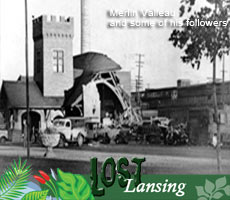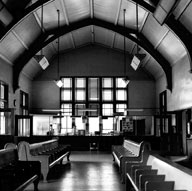 The soon to be revamped Grand Trunk railroad station on south Washington Ave has undergone major renovations before. It is the scene of what was described as the “most disastrous wreck in Lansing’s history.†On Tuesday October 7, 1941 a hurtling boxcar smashed into the southwest corner of the building, gouging a hole and partially collapsing the roof.
The soon to be revamped Grand Trunk railroad station on south Washington Ave has undergone major renovations before. It is the scene of what was described as the “most disastrous wreck in Lansing’s history.†On Tuesday October 7, 1941 a hurtling boxcar smashed into the southwest corner of the building, gouging a hole and partially collapsing the roof.
Approximately a quarter after 4 pm, as the freight train passed through town, wheels on the 18th car behind the locomotive fractured. It jumped the track causing the remaining 32 cars to jam and derail. The initial car was as thrown across Cedar Street. One of the following boxcars plunged into the station. Witnesses estimated the train was traveling nearly 70 miles per hour.
The smashed and twisted wreckage lay scattered for nearly a quarter mile along the track, a block west of Washington to Cedar. Thousands gathered to survey the splintered boxcars and demolished station. The lone fatality was 13-year-old newspaper boy James R. Smith, who was selling magazines. He was hit by flying wreckage as he stood on the platform. Over a dozen others were hospitalized. Many more suffered minor injuries. Beds at St. Lawrence and Edward S. Sparrow hospitals exceeded capacity.
Greater calamity was averted by Grand Trunk officials who stopped a passenger train scheduled to pass the same route minutes after the wreck. Reports describe numerous narrow escapes. Several automobiles were crushed as boxcars barreled across a parking lot. W. Grover Hartley, the gateman, jumped from his tower seconds before the train careened into it. It was the second time in four years the tower was smashed by a runaway train.
Despite the extensive destruction both freight and passenger service resumed the following day. Over 200 workers on Grand Trunk clean-up crews from Detroit and Battle Creek were on scene before dark. With torches and searchlights they worked through the night. The building was swiftly repaired. It remained in service until 1971. Later it became a restaurant and was added to the National Register of Historic Places in 1978. By the turn of the 21st century it was abandoned.
The building opened in January of 1903. It replaced a smaller, less festooned, wood structure. Construction cost over $40K. By period standards it was not large. However, it was elaborately bedecked and described that “nowhere between Portland, ME., and Chicago, ILL., is there a handsomer passenger depot.†The white sandstone and pressed brick were set off with green trim. A “commodious waiting room†was ringed in white tile wainscoting which met white, blue and gold fresco. The rounded ceiling and all woodwork were oak, as was the furniture. There was a “magnificent†fireplace framed by floor to ceiling marble columns, a men’s smoking room and a ladies waiting room “richly furnished†complete with “comfortable†rocking chairs.
As reported in Lansing City Pulse, Lansing BWL officials have given assurances the structure will be restored “just like it was originally.â€

I remember catching a train there in the mid 60s and hoisting a beer there in the late 70s.
This is really of gem of train architecture
Good article, Dave! I’ve seen photos of that wreck, but I didn’t know the story of it.
I enjoyed dining & dancing in The Depot when it briefly re-opened as a restaurant and space for live blues I believe in the late 90′s and early 2000′s. It had great ambiance and charm.
I have been searching for pictures and information about this wreck. I knew it happened because I was there just about 200 feet north in front of Paul’s grocery store. I had stopped to buy a Powerhouse candy bar and was sittIng on my bicycle eating it when the train came through. Normally I would have been standing right down by the tracks and believe that Powerhouse saved my life. I was 9 years old and at almost 80 now I still have a vivid picture of those railroad cars buckling and tipping over. I was 5 blocks from my home and had to bicycle several blocks to Cedar street bridge to get across the tracks. Looking over the bridge railing I saw the engine with A few cars still connected to it. When I arrived home my mother would not believe my story and had to walk down to Washington ave to see for herself. I would really appreciate any comments. Walt or Jerry as I was nicknamed then.